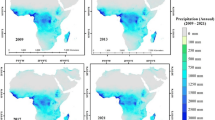Abstract
The intense interest in desertification and climate change has stimulated detailed studies of temperature records in many areas of the world. In this investigation, the temperature records from the Middle East region are analyzed over the period 1950–1990. Results reveal a linear, statistically significant temperature increase of 0.07 °C/decade over the 41-year period. An analysis of spatial controls on these temperature changes reveals a warming effect associated with both overgrazing and the degree of human-induced desertification. The results of this study are consistent with theoretical and empirical studies predicting and demonstrating a warming signal associated with these land surface changes in the world's dryland areas.
Similar content being viewed by others
References
Balling, R.C., Jr. 1991. Impact of desertification on regional and global warming. Bulletin of the American Meteorological Society 72: 232–234.
Bounova, L. and T.N. Krishnamurti. 1993a. Influence of soil moisture on the Sahelian climate prediction I. Meteorology and Atmospheric Physics 52: 183–203.
Bounova, L. and T.N. Krishnamurti. 1993b. Influence of soil moisture on the Sahelian climate prediction II. Meteorology and Atmospheric Physics 52: 205–224.
Bryant, N.A., L.F. Johnson, A.J. Brazel, R.C. Balling, Jr., C.F. Hutchinson and L.R. Beck. 1990. Measuring the effect of overgrazing in the Sonoran Desert. Climatic Change 17: 243–264.
Charney, J.G. 1975. Dynamics of deserts and drought in the Sahel. Quarterly Journal of the Royal Meteorological Society 101: 193–202.
Charney, J.G., P.H. Stone and W.J. Quirk. 1975. Drought in the Sahara: A biogeophysical feedback mechanism. Science 187: 434–435.
Dregne, H.E. 1977. Generalized map of the status of desertification of arid lands. Prepared by FAO of the United Nations, UNESCO and WMO for the 1977 United Nations Conference on Desertification.
Druyan, L.M. 1989. Advances in the study of sub-Saharan drought. International Journal of Climatology 9: 77–90.
Franchito, S.H. and V.B. Rao. 1992. Climatic change due to land surface alterations. Climatic Change 22: 1–34.
Houghton, J.T., B.A. Callander and S.K. Varney (editors). 1992. Climate change 1992: The supplementary report to the IPCC scientific assessment. Cambridge University Press, Cambridge.
Houghton, J.T., G.J. Jenkins and J.J. Ephraums (editors). 1990. Climate change: The IPCC scientific assessment, Cambridge University Press, Cambridge.
Idso, S.B. 1977. A note on some recently proposed mechanisms of genesis of deserts. Quarterly Journal of the Royal Meteorological Society 103: 369–370.
Idso, S.B. and J.W. Deardorff. 1978. Comments on “The effect of variable surface albedo on atmospheric circulation in desert regions.” Journal of Applied Meteorology 7: 560.
Jackson, R.D. and S.B. Idso. 1975. Surface albedo and desertification. Science 189: 1012–1013.
Jones, P.D., T.M.L. Wigley and P.B. Wright. 1986. Global temperature variations between 1861 and 1984. Nature 322: 430–434.
Nasrallah, H.A. and R.C. Balling, Jr. 1993. Spatial and temporal analysis of Middle Eastern temperature changes. Climatic Change 25: 153–161.
Nasrallah, H.A. and R.C. Balling, Jr. 1994. The effect of overgrazing on historical temperature trends. Agricultural and Forest Meteorology 71: 425–430.
Novak, M.D. 1990. Micrometeorological changes associated with vegetation removal and influencing desert formation. Theoretical and Applied Climatology 42: 19–25.
Ripley, E.A. 1976a. Comments on the paper ‘Dynamics of deserts and droughts in the Sahel’ by J.G. Charney. Quarterly Journal of the Royal Meteorological Society 102: 466–467.
Ripley, E.A. 1976b. Drought in the Sahara: Insufficient biogeophysical feedback? Science 191: 100.
Sud, Y.C., W.C. Chao and G.K. Walker. 1993. Dependence of rainfall on vegetation: Theoretical considerations, simulation experiments, observations and influences from simulated atmospheric soundings. Journal of Arid Environments 25: 5–18.
United Nations Environment Programme (UNEP). 1992. World atlas of desertification, Edward Arnold, London.
Wendler, G. and F. Eaton. 1983. On the desertification of the Sahel zone. Climatic Change 5: 365–380.
Yang, R., J. Shukla and P.J. Sellers. 1994. The influence of changes in vegetation type on the surface energy budget. Advances in Atmospheric Sciences 11: 139–161.
Author information
Authors and Affiliations
Rights and permissions
About this article
Cite this article
Nasrallah, H.A., Balling, R.C. Impact of desertification on temperature trends in the Middle East. Environ Monit Assess 37, 265–271 (1995). https://doi.org/10.1007/BF00546894
Issue Date:
DOI: https://doi.org/10.1007/BF00546894




